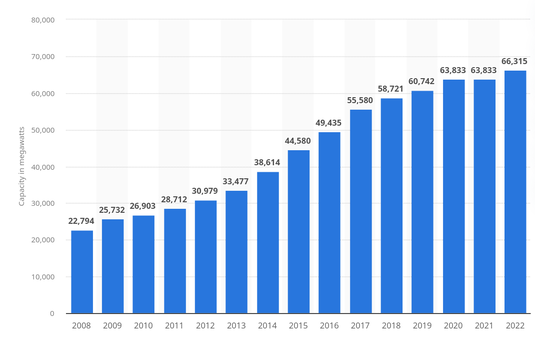Growth in german wind capacity is slowing. Soo… then the plan is to keep on with lignite and gas? Am I missing something?
Installed Wind Capacty - Germany

Growth in german wind capacity is slowing. Soo… then the plan is to keep on with lignite and gas? Am I missing something?
Installed Wind Capacty - Germany

For centralisation - large areas of the grid are dependent on a few locations, so if there is an issue with one or two areas, the entire network can fail. Say for example if there is an earthquake which disables two nuclear power plants, that could cause massive issues with the grid.
If you have many small power sources distributed across a larger area, it significantly mitigates the issue - the loss of even dozens or hundreds of wind turbines would be able to be handled much more responsively.
Nuclear is uniquely disadvantaged at having very bad responsiveness to demand. Renewables are extremely good at that, coincidentally.
For security, I’m sure you can imagine many scenarios, but nuclear waste is a potential target for creating dirty bombs for example.
First off appreciate the good faith response. It’s more than I’ve come to expect when I ask (probably) dumb questions requesting further explanation.
Coming from an American perspective, I’ve only recently realized just how badly centralization affects the grid. It’s definitely a strong case for rooftop solar.
But focusing on nuclear, I do think we’ve missed the window where building top-to-bottom nuclear generating facilities would be advantageous, but in the effort to bridge from our heavily fossil fuel based electrical grid to a completely renewable, I think that SMRs are a reasonable solution. I especially like the notion of converting old infrastructure (i.e. old abandoned coal plants) into SMR power plants.
You seem to be knowledgeable and have opinions. What’re you’re thoughts on SMRs to help bridge the growing energy need?
Unfortunately simply using renewables alone is t enough to decentralize them. Lately Texas has been having near energy shortages and part of the problem is a few unexpected central outages at fossil fuel plants, but another is the vast majority of wind turbines are built in one sunset of the state, so if wind is low there it can (and has) cause massive decreased in available energy, far larger than a couple traditional large scale nuclear plants when other parts of the state are under fire warnings because of high wind and dry conditions. Of course this isn’t an issue with the technology itself, but rather a problem with implementation. The issue isn’t with what was built, but the lack of building more across the state (or joining one of the two larger grids to further decentralize power production over a broader area)
Anyways, another issue with security is centralized power production make a good target for disruption. And if you have the side effect of causing a meltdown…
Man, the US is a total mess. Why does Texas have a separate power grid? If the US invested in renewables and energy infrastructure they would easily become the #1 renewable energy producer in the world. They have so many ideal geographical features it’s absolutely crazy how much they’re going to waste.
Ironically, I seen the claim that the original reason was because the US grid was outdated and Texas wanted to do better. Probably back when people who called themselves “conservatives” actually cared at little bit about conserving the environment (at least in some self-interested ways). Of course it didn’t work out that way.
No clue why the rest of the US is divided into two grids.
Can you explain to me how you adjust renewable to the demand ? How can you increase the amount of sun or wind in the evening when there is a peak of demand?
For the nuclear you can go from 100% to 20% or the opposite in less 30 minutes. It can also follow the load and have a variation of 5% in 30s.
https://archive.wikiwix.com/cache/index2.php?url=http%3A%2F%2Fwww.oecd-nea.org%2Fndd%2Freports%2F2012%2Fsystem-effects-exec-sum.pdf
100% to 20% in 30 minutes, huh? Even if that’s true - I doubt even a quarter of all nuclear power plants in use today can accomplish that - all wind turbines in the world can go from 100% to 0% in a matter of seconds, with no human intervention.
Wind turbines are actually surprisingly complex machines with many ways to control the power generation, for all important metrics: voltage, power, frequency, etc.
Essentially the main variables at play are rotational torque and rotor speed, and there’s a lot of ways to control those variables. For example, the rotor can be rotated to face the wind at the ideal angle, or the pitch of the blades can be tweaked. There are also components quite like those you’d find in a car - brakes, clutch, gearbox, etc. which control the rotor speed and rotational torque. All of these systems are intelligently controlled and responsive, and allow very fast response to changes in demand or weather conditions without human input.
Solar panels, similarly, can be angled - commercial solar farms are usually motorised. This is mostly done so the panels can track the sun, making them much more efficient, but it also means they can be angled away from the sun, if need be, to reduce output. In reality, this isn’t really done, because it’s easier to control wind - solar provides baseline power and wind builds on top of that and adds responsiveness.